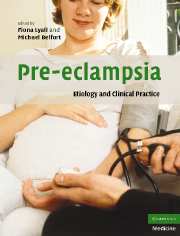Book contents
- Frontmatter
- Contents
- List of contributors
- Preface
- Part I Basic science
- Part II Clinical Practice
- 17 Classification and diagnosis of pre-eclampsia
- 18 Measuring blood pressure in pregnancy and pre-eclampsia
- 19 Immune maladaptation in the etiology of pre-eclampsia; an updated epidemiological perspective
- 20 Genetics of pre-eclampsia and counseling the patient who developed pre-eclampsia
- 21 Thrombophilias and pre-eclampsia
- 22 Medical illness and the risk of pre-eclampsia
- 23 The kidney and pre-eclampsia
- 24 Management of mild pre-eclampsia
- 25 Management of severe pre-eclampsia
- 26 The differential diagnosis of pre-eclampsia and eclampsia
- 27 Complications of pre-eclampsia
- 28 Central nervous system findings in pre-eclampsia and eclampsia
- 29 Pathogenesis and treatment of eclampsia
- 30 Anesthesia for the pre-eclamptic patient
- 31 Critical care management of severe pre-eclampsia
- 32 The role of maternal and fetal Doppler in pre-eclampsia
- 33 Pregnancy-induced hypertension – the effects on the newborn
- 34 Medico-legal implications of the diagnosis of pre-eclampsia
- Subject index
- References
18 - Measuring blood pressure in pregnancy and pre-eclampsia
from Part II - Clinical Practice
Published online by Cambridge University Press: 03 September 2009
- Frontmatter
- Contents
- List of contributors
- Preface
- Part I Basic science
- Part II Clinical Practice
- 17 Classification and diagnosis of pre-eclampsia
- 18 Measuring blood pressure in pregnancy and pre-eclampsia
- 19 Immune maladaptation in the etiology of pre-eclampsia; an updated epidemiological perspective
- 20 Genetics of pre-eclampsia and counseling the patient who developed pre-eclampsia
- 21 Thrombophilias and pre-eclampsia
- 22 Medical illness and the risk of pre-eclampsia
- 23 The kidney and pre-eclampsia
- 24 Management of mild pre-eclampsia
- 25 Management of severe pre-eclampsia
- 26 The differential diagnosis of pre-eclampsia and eclampsia
- 27 Complications of pre-eclampsia
- 28 Central nervous system findings in pre-eclampsia and eclampsia
- 29 Pathogenesis and treatment of eclampsia
- 30 Anesthesia for the pre-eclamptic patient
- 31 Critical care management of severe pre-eclampsia
- 32 The role of maternal and fetal Doppler in pre-eclampsia
- 33 Pregnancy-induced hypertension – the effects on the newborn
- 34 Medico-legal implications of the diagnosis of pre-eclampsia
- Subject index
- References
Summary
Introduction
Blood pressure is measured routinely during the antenatal period. Accurate blood pressure measurement is essential to the diagnosis and management of hypertension in pregnancy. The gold standard for measuring indirect blood pressure is the mercury sphygmomanometer, although it is widely acknowledged that it has associated errors and that alternatives are not dependent on the skill of the observer, which can have significant advantages.
One such alternative is automated equipment. However, the inherent inaccuracies of most automated devices are confounded by the altered hemodynamic state of pregnancy and especially pre-eclampsia. Evidence already points to significant inaccuracies in women with pre-eclampsia. However, as most of these devices are intended for home monitoring they have the potential to reduce inpatient monitoring whilst improving surveillance. The role of this type of monitoring is yet to be to established.
It is of critical importance that these devices are evaluated according to a recognized protocol, i.e. the British Hypertension Society, the European Society of Hypertension or the Association for the Advancement of Medical Instrumentation, before their accuracy in clinical practice, and especially an obstetric population, can be assumed.
Accurate and precise technique and the use of properly calibrated and well-maintained equipment is vital.
The importance of blood pressure in pregnancy
The importance of blood pressure measurement during pregnancy has been recognized for more than a century (Seligman, 1987) and is a fundamental part of antenatal care.
- Type
- Chapter
- Information
- Pre-eclampsiaEtiology and Clinical Practice, pp. 258 - 275Publisher: Cambridge University PressPrint publication year: 2007
References
- 1
- Cited by



